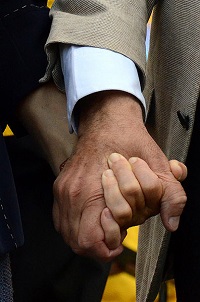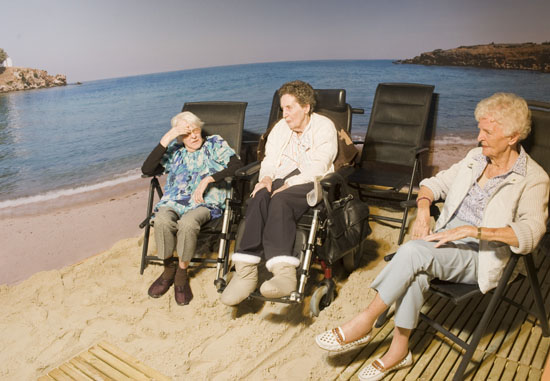From Facebook’s purchase of Oculus VR Inc. to the latest medical developments, technology is driving new explorations of the perception, reality, and neuroscience. How do we perceive reality through the sense of touch? Alberto Gallace is a researcher in touch and multisensory integration at the University of Milano-Bicocca, Italy, and co-author of In touch with the future: The sense of touch from cognitive neuroscience to virtual reality. We recently spoke to him about touch, personal boundaries, and being human.
Out of all the human senses, touch is the one that is most often unappreciated, and undervalued. When did you first become interested in touch research?
I was in Oxford as a visiting PhD student and working on multisensory integration, in particular on the integration between tactile and visual signals in the brain. Soon I realized that, despite the fact that is a very important sensory modality, there was not much research on touch, and there were not even a lot of instruments to study such sensory modality. I started by working more with engineers and technical workshops then with psychologists and neuroscientists, just because I needed some device to test the sense of touch in a different way as compared to what was done in the past. Touch was mainly studied with reference to haptic object recognition, mostly on visually impaired individuals or in terms of its physiological mechanisms. Many of the most relevant aspects of touch were very little, if not at all, investigated.
 We use touch for walking, talking, eating, nearly everything basically. It also plays a major role on our interpersonal relationships, it affects the release of hormones and it contributes to define the boundary of our self.
We use touch for walking, talking, eating, nearly everything basically. It also plays a major role on our interpersonal relationships, it affects the release of hormones and it contributes to define the boundary of our self.
To my students I often say, where our touch begins, we are. I wanted to understand more of these topics. I wanted to compare touch with other sensory modalities. In doing that I was convinced that research on touch had to get away from the fingertips or hands and extend to the whole body surface. The more I studied this sense, the more I became interested in it. For every question answered there were many more without responses. I like touch a lot because there are many things that still need to be understood about it, and I am a rather curious person, particularly when it comes to science.
What do you think has been the most important development in touch research in the past 100 years?
I am not sure if it’s the most important development, but what I certainly consider important is the recent study of certain neural fibres specialized in transmitting socially-relevant information via the sense of touch. That is, the C tactile afferents in humans, that are strongly activated by ‘caress like’ stimuli, might play an important role in many of our most pleasant social experiences. However, I should also say that my personal way to think about science is much more ‘future oriented’. That is, I believe that the most important developments in touch research are the ones that we will see in the next years. I am really looking forward to reading (or possibly writing) about them.
Why did you decide to research this topic?
Most of the previously published books on touch — there aren’t many, to be honest — were focused on a single topic. Most of them were based on research on visually-impaired individuals, and the large majority of them were authored books, a collections of chapters written by different people, sometimes with a different view. Charles [Spence, University of Oxford] and myself wanted something different, something more comprehensive, something that could help people to understand that touch is involved in many different and relevant aspects of our life. We envisioned a book where the more neuroscientific aspects of touch were addressed together with a number of more applied topics. We wanted something where people could see touch ‘at work’. We talk about the neural bases of touch, tactile perception, tactile attention, tactile memory, tactile consciousness, but also about the role of touch in technology, marketing, virtual reality, food appreciation, and sexual behaviour. Many of these topics have never been considered in a book on touch before.

Philippe Mercier’s The Sense of Touch
What do you see as being the future of research in this field in the next decade?
I think that research in my field, pushed by technological advances, will grow rapidly in the coming years. One of the fields where I see a lot of potential is certainly related to the reproduction of tactile sensations in virtual reality environments. Virtual reality will likely become an important part of our life, maybe not in the next decade, but certainly in a not so distant future. However, if we want to create believable virtual environments we need to understand more of our sense of touch, and in particular how our brain processes tactile information, how different tactile stimulations can lead to certain emotions and behaviours, and how tactile sensations can be virtually reproduced. Following the idea that ‘where our touch begins, we are’, research will certainly invest a lot of resources in trying to better understand the neurocognitive mechanisms responsible for supporting our sense of ‘body ownership’ (the feeling that the body is our own) and how this sense can be transferred to virtual/artificial counterparts of our self. Here research on touch will certainly play a leading role.
If you weren’t doing touch research, what would you be doing?
I think I’d work as a scientist in a different field, but always as a scientist. I am too curious about how nature works to do something different. Since I was twelve I’ve always had a special interest in astronomy and astrophysics and I can easily picture myself working in that field too. Understanding the secrets of black cosmic matter or studying the mysteries of white brain matter? Not sure which would be better. What I am sure about is that I like my job a lot, and I won’t change it with anything else that is not based that much on creativity and curiosity.
Alberto Gallace is a researcher at Department of Psychology, University of Milano-Bicocca, Italy, and co-author of In touch with the future: The sense of touch from cognitive neuroscience to virtual reality. His research interests include spatial representation, multisensory integration, tactile perception, tactile interfaces, body representation, virtual reality, sensory substitution systems, and neurological rehabilitation of spatial disorders.
Subscribe to the OUPblog via email or RSS.
Subscribe to only brain sciences articles on the OUPblog via email or RSS.
Image credits: (1) Via Catalana Barcelona Plaça Catalunya 37. Photo by Judesba. CC-BY-SA-3.0 via Wikimedia Commons. (2) The Sense of Touch, painting by Philipe Mercier. Public domain via Wikimedia Commons
The post A conversation with Alberto Gallace appeared first on OUPblog.



